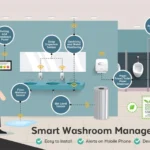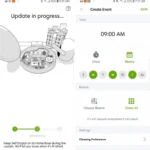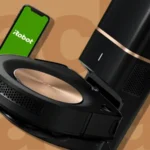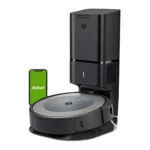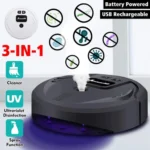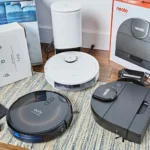Have you ever wondered how your smart vacuum cleaner navigates around your home without falling off the stairs or damaging your furniture? That’s where drop sensors come in. These innovative sensors are crucial components of modern vacuum cleaners that ensure safe and efficient cleaning. In this article, we will explore the importance of drop sensors in smart vacuum cleaners and why they are a must-have for every homeowner looking to keep their floors clean without any hassle. So, let’s dive in and learn everything you need to know about this fascinating technology.
What are Drop Sensors?
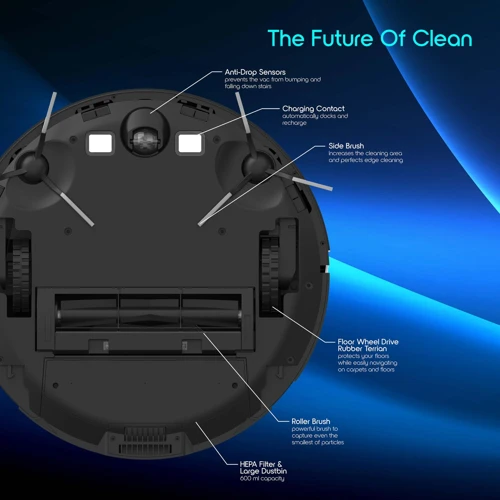
Drop sensors are an important aspect in ensuring that smart vacuum cleaners function efficiently and safely. These sensors help smart vacuum cleaners detect sudden drops and edges, such as stairs or ledges, to avoid falling off and sustaining damage.
Smart vacuum cleaners equipped with drop sensors are able to navigate around a space without continuous human supervision. The sensors act as an extra set of eyes for the vacuum cleaner, ensuring that it does not fall off an edge or down the stairs. Without these drop sensors, smart vacuum cleaners might not be able to effectively navigate a space due to safety concerns.
Drop sensors in smart vacuum cleaners are typically located on the underside of the devices, close to the wheels. These sensors use various technologies such as infrared, laser, and camera sensors to detect changes in elevation. Once a drop sensor detects a sudden drop or edge, it signals the vacuum to change its direction or stop before it falls off.
Drop sensors are crucial to the safety of both the vacuum cleaner and other objects in a room. Without these sensors, the vacuum cleaner might collide with objects or fall off edges, damaging the device and potentially causing harm to people or pets in the area.
Additionally, drop sensors save time and effort, as they allow smart vacuum cleaners to navigate around the room without the need for constant human intervention. They help users save time by preventing the vacuum cleaner from colliding with obstacles and falling off edges, adding to the overall efficiency of the device.
Drop sensors are essential in ensuring that smart vacuum cleaners work efficiently and safely. If you are considering investing in a smart vacuum cleaner, it is vital to choose a model that has drop sensors. You can check out our guide on top smart vacuum cleaners with drop sensors to help you choose the right one for your needs. However, if you prefer a simpler model, we have also reviewed smart vacuums without drop sensors.
How do Drop Sensors Work?
Drop sensors are an essential feature in smart vacuum cleaners as they help prevent the machine from falling down the stairs or tumbling off a ledge. But how do these sensors work to keep the vacuum cleaner safe and secure?
Drop sensors use various technologies to detect changes in floor height and prevent the vacuum cleaner from falling off the edge. Typically, these sensors are situated underneath the cleaner and operate by emitting radiation downwards and then analyzing its reflection. The sensors can detect when the robot moves from a flat surface to a point where there is nothing underneath, and then signals the machine to halt or change direction.
There are various types of drop sensors used in smart vacuum cleaners which include infrared sensors (IR), cliff sensors, LIDAR sensors, and camera sensors. Infrared sensors detect heat signatures and are used to detect the height below the vacuum cleaner by sending out infrared light, which bounces back when it meets an obstacle. The amount of reflected light is then used to gauge the distance between the sensor and any obstructions on the floor.
Cliff sensors use optical sensors that project infrared light at a downward angle to identify any cliff-like drops in its path. If the cleaner is moving over an open space such as stairs, it can detect the potential drop-off and stop before falling.
LIDAR sensors use pulsed lasers to create a detailed map of the environment by measuring the time it takes for light to reflect off surfaces. A LIDAR sensor is capable of creating a 3D map of the area around it, enabling the robot to detect not just drops but also walls, furniture, and other obstacles.
Camera sensors, on the other hand, use a camera mounted underneath the machine to interpret the surroundings around the vacuum cleaner. They are particularly useful in identifying areas that need cleaning, and like the other types of sensors, can detect changes in surface levels that could result in a fall.
Drop sensors are an essential feature in smart vacuum cleaners, and they use various technologies such as IR, cliff sensors, LIDAR sensors, and camera sensors to detect obstacles and avoid damage. Understanding how drop sensors work is a crucial step in choosing the right smart vacuum cleaner for your home.
Why are Drop Sensors Important?
Without drop sensors, smart vacuum cleaners would pose a danger to themselves, household items, and family members. These sensors are essential in ensuring that the cleaning process is efficient and safe. If you’re still skeptical about the importance of drop sensors in smart vacuums, keep reading to understand why they’re a must-have feature.
Firstly, drop sensors prevent falls and damage. Smart vacuum cleaners without drop sensors could easily navigate through stairs or off a high surface, causing permanent damage or even breaking the machine. With drop sensors, however, smart vacuums can detect when they’re near ledges, stairs or other steep inclines and adjust their movement accordingly, preventing damage and protecting the vacuum user.
These sensors save time and effort. Cleaning floors takes time and effort, and the last thing anyone wants is to end up with a machine that doesn’t work as expected, or worse, one that requires constant supervision. Drop sensors ensure that the cleaning process continues unhampered, without the need for constant monitoring or repositioning of the vacuum cleaner.
Finally, drop sensors make cleaning easy and safe. They help eliminate the need for manual cleaning since the robot effortlessly navigates through the house without getting into trouble. With these sensors, you can sit back, relax and let the smart vacuum do the cleaning, avoiding the need to navigate precarious or hard-to-reach areas yourself.
Drop sensors are foundational to the success of smart vacuums, and should be considered non-negotiable when choosing a vacuum cleaner. By incorporating these sensors into their design, manufacturers have made life easier by promoting safe and convenient home cleaning. With these sensors, smart vacuums not only save you time, but they make cleaning more effortless, allowing you to focus on more important things. To learn more about the benefits of drop sensors in smart vacuums, check out our previous article.
The Benefits of Drop Sensors in Smart Vacuum Cleaners
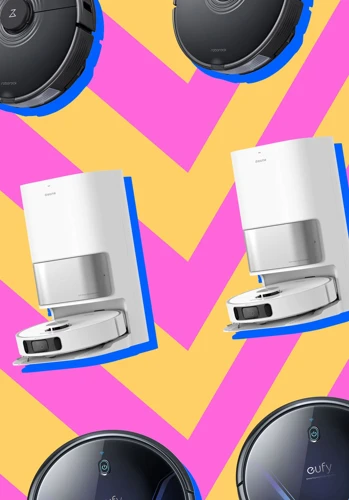
Smart vacuum cleaners have revolutionized the way we clean our homes. They have made it easier and more efficient to keep our living spaces tidy, without much effort from us. One of the most important features of smart vacuum cleaners is the use of drop sensors. These sensors have numerous benefits that make smart vacuum cleaners more effective and reliable than traditional ones.
Prevent Falls and Damage
The most important benefit of drop sensors is that they prevent your smart vacuum cleaner from falling off stairs or edges, as they can sense such drop-offs. This not only protects the vacuum cleaner itself from damage, but also ensures the safety of other items around the drop-off point, as well as the people and pets in the home.
Without these sensors, the vacuum cleaner could easily fall off stairs, damaging itself and anything in its path. Imagine the danger of a vacuum cleaner with a metal body falling off a second-floor landing, it could cause serious damage to the house, injure someone or even worse, damage your paid for smart vac.
Save Time and Effort
Drop sensors in smart vacuum cleaners help to save time and effort. With these sensors, the vacuum cleaner can automatically avoid edges and drops, which means that you don’t have to worry about monitoring it constantly while it cleans. You can simply set it on the desired program and let it do its work more efficiently.
Without drop sensors, you would have to manually move the vacuum cleaner around, avoiding edges and drops yourself. This not only takes up more time and effort but it also limits the effectiveness of the cleaning by missing out on hard-to-reach areas.
Easy and Safe Cleaning
Smart vacuum cleaners with drop sensors make cleaning easy and safe. They can be trusted to clean your floors effectively without the risk of damage to themselves, your home or other valuable belongings. This is particularly useful when cleaning tight spaces or deep-cleaning your floors.
Without these sensors, cleaning with a vacuum could be dangerous and risky as the vacuum cleaner remains unaware of the danger posed by stairs and other drop-offs. Vacuuming would be a painful task, increasing the risk of fatigue and injury.
Drop sensors are an essential feature of modern smart vacuum cleaners. They make cleaning easier, safer, and more efficient, and protect the vacuum cleaner and other items around it from damage. If you are considering a smart vacuum cleaner, it is crucial to choose one that has dependable drop sensors. To learn more about the importance of drop sensors in smart vacuum cleaners, checkout /drop-sensors-smart-vacs/.
Prevent Falls and Damage
Smart vacuum cleaners equipped with drop sensors can prevent falls and damage that can occur during cleaning. These sensors work by detecting edges, gaps or steep drops in the floor. Once detected, the sensors communicate with the vacuum’s internal software, prompting it to either stop or adjust its movement accordingly to prevent the device from falling off the edge.
This is especially useful when cleaning staircases or areas with raised surfaces like kitchen counters. Without a drop sensor, your smart vacuum cleaner may accidentally pass over the edge and plummet to the ground, causing significant damage to the device and your floor.
Additionally, a vacuum’s drop sensor can also prevent it from getting tangled in wires or getting stuck under furniture. The sensor can detect the obstacle and signal the vacuum to stop its movements and avoid getting entangled or causing damage.
As a result, investing in a smart vacuum cleaner with a drop sensor can save you time and money in the long run. Not only does it provide an extra layer of protection for your floors and the device itself, but it also minimizes the risk of accidents or injury while cleaning.
The drop sensor feature in smart vacuum cleaners is very important and has revolutionized the way we approach cleaning tasks at home. It reduces the chance of accidents and damage, ensuring that your cleaning experience is as effortless and safe as possible.
Save Time and Effort
Smart vacuum cleaners with drop sensors offer various advantages, one of the most significant being the ability to save both time and effort for the homeowner. With traditional vacuum cleaners, it can be challenging to move furniture or other items around in order to clean a room efficiently. However, with a smart vacuum cleaner that has drop sensors, users can easily set up the device and let it do the work for them.
Automatic Navigation: One of the key features of smart vacuum cleaners with drop sensors is their ability to navigate a room autonomously. This allows them to effectively clean areas under furniture, which are generally hard to reach for traditional vacuum cleaners. These devices are capable of mapping a room’s layout and using sensors to detect potential obstacles or changes in the terrain. This means that homeowners no longer have to spend extra time and effort manually moving furniture around.
Efficient Cleaning: Smart vacuum cleaners with drop sensors offer efficient cleaning, which saves a significant amount of time and effort for homeowners. The sensors in these devices can accurately detect edges, stairs, and other potential drop-offs or obstacles. This means that users don’t have to worry about carefully navigating the device through their home in order to avoid damage or falls. Instead, they can simply turn on the vacuum and let it do its job, saving them precious time and effort.
Hands-Free Operation: An additional benefit of smart vacuum cleaners with drop sensors is that they offer hands-free operation. With traditional vacuum cleaners, users have to hold the device and manually move it around the room. This can be tiring, especially for those who have large homes or have to vacuum frequently. However, smart vacuum cleaners with drop sensors allow users to simply turn on the device and let it do its job. This leaves homeowners free to focus on other tasks while their floors get efficiently cleaned.
Smart vacuum cleaners with drop sensors are a fantastic tool for saving time and effort. They offer automatic navigation, efficient cleaning, and hands-free operation. With these features and benefits, homeowners no longer have to worry about manually cleaning their floors and can instead focus on other tasks.
Easy and Safe Cleaning
One of the most significant benefits of smart vacuum cleaners with drop sensors is the easy and safe cleaning they provide. With an automated vacuuming system equipped with drop sensors, you can say goodbye to the hassle of worrying about accidents caused by a vacuum cleaner falling off stairs and damaging your flooring.
The drop sensors provide a safety net that prevents the vacuum cleaner from taking a deadly plunge off stairs or steep surfaces. The sensors detect an impending fall and alert the vacuum cleaner to change its direction, circumventing any danger.
The safety element provided by these drop sensors is particularly crucial for families with young children and pets. Toddlers and pets are known to have a penchant for mischief and are prone to accidents. With a smart vacuum cleaner using drop sensors, you can have peace of mind knowing that they are safe from any harm that could result from vacuuming.
Smart vacuum cleaners with drop sensors not only provide safety but also make cleaning easier. They are designed to navigate through obstacles and avoid any fall or damage, meaning you won’t have to worry about moving any furniture or tripping hazards that might otherwise be hazardous.
You can program your smart vacuum cleaners with drop sensors to clean autonomously without needing round-the-clock attention. You can achieve a clean environment without exerting any effort or disrupting your daily routine. The convenience this brings is unmatched, as it enables you to focus on other essential tasks while your home is kept clean and orderly.
Smart vacuum cleaners with drop sensors offer an excellent solution to the challenges of cleaning homes. Their safety features prevent falls or damage and provide the ease of cleaning that every homeowner desires. They are designed to provide convenience while cleaning your home, allowing you to focus on other essential tasks.
Types of Drop Sensors in Smart Vacuum Cleaners
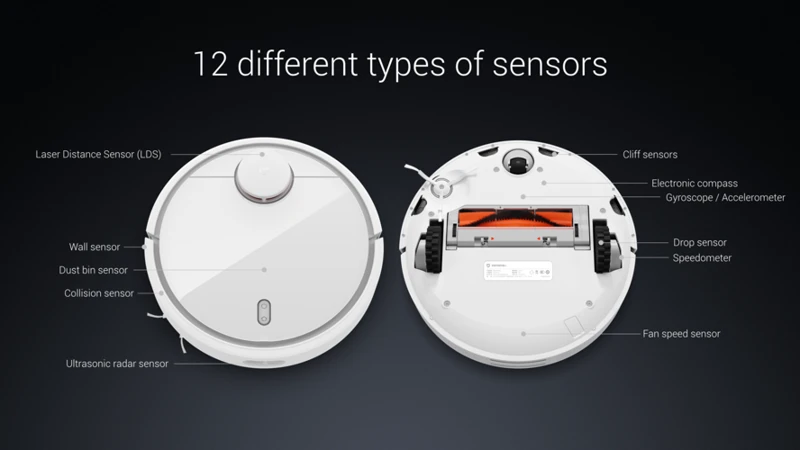
When it comes to smart vacuum cleaners with drop sensors, there are several types of sensors that can be used. The type of sensor used in a smart vacuum cleaner can affect its performance, cost, and features. Here are the most common types of drop sensors used in smart vacuum cleaners:
IR or Infrared Sensors: IR sensors are widely used in smart vacuum cleaners because they are affordable and reliable. These sensors emit a beam of infrared light, which bounces back when it encounters an obstacle. If the beam doesn’t bounce back, it means that there is no surface or object below the vacuum cleaner. IR sensors are usually placed at the bottom of the vacuum cleaner, and they work well on flat surfaces.
Cliff Sensors: Cliff sensors, also known as bumper sensors, are more advanced than IR sensors. They can detect drops and cliffs, and they are usually used in high-end smart vacuum cleaners. These sensors use sound waves to detect changes in the surface below the vacuum cleaner. When a drop is detected, the vacuum cleaner stops and changes direction to avoid falling. Cliff sensors are more expensive than IR sensors, but they provide better protection against falls.
LIDAR Sensors: LIDAR sensors are the most advanced type of drop sensor used in smart vacuum cleaners. They use lasers to create a 3D map of the room and detect drops, cliffs, and other obstacles. LIDAR sensors are highly accurate and can detect small changes in the surface below the vacuum cleaner. However, they are also the most expensive type of sensor, and they are usually only found in high-end smart vacuum cleaners.
Camera Sensors: Camera sensors are not as common in smart vacuum cleaners as other types of sensors. However, some high-end models use camera sensors to detect drops and cliffs. These sensors take pictures of the floor and analyze them to identify drops and obstacles. Camera sensors are highly accurate, but they can also be expensive and require more processing power than other types of sensors.
The type of drop sensor used in a smart vacuum cleaner depends on the manufacturer’s preference, the price point of the vacuum cleaner, and the intended use of the product. It’s important to consider the type of sensor when choosing a smart vacuum cleaner, as it can affect the vacuum cleaner’s performance and cost.
IR or Infrared Sensors
One type of drop sensor commonly seen in smart vacuum cleaners are IR or infrared sensors. These sensors work by emitting a beam of invisible infrared light that bounces off objects and reflects back to the sensor. The sensor can detect the distance of an object by measuring the time it takes for the light to reflect back.
One of the benefits of using infrared sensors is their affordability. They are relatively inexpensive to produce and integrate into smart vacuums. They are highly accurate and can consistently detect objects in their range.
However, infrared sensors may not be as effective in environments with high levels of ambient light or reflective surfaces, as this may interfere with the sensor’s ability to detect objects accurately. They also have a limited range, which may require the vacuum cleaner to be closer to an edge or object before a fall is detected.
Despite these limitations, many smart vacuum cleaners still utilize infrared sensors as a primary method of detecting drops and other hazards. They are a reliable and cost-effective solution for many households and can help prevent damage to both the cleaner and the surrounding area.
Cliff Sensors
Cliff sensors are another type of drop sensor used in smart vacuum cleaners. These sensors use infrared signals to map out the vacuum’s surroundings and detect any drop-offs or cliffs. The sensors work by emitting infrared signals and then measuring the time it takes for the signals to bounce back.
Unlike IR sensors, cliff sensors do not detect objects or obstacles in their path. Instead, they are designed specifically to detect drops in height, such as stairs or ledges. In the event that the vacuum encounters a drop-off, the cliff sensors will signal to the vacuum’s navigation system to change direction and avoid the danger.
One of the benefits of cliff sensors is that they allow for more precise navigation. By detecting drop-offs and cliffs, the vacuum can more easily map out the area it needs to clean and avoid areas where it could potentially get stuck or damaged.
Cliff sensors are also important for preventing falls and damage to both the vacuum and the surrounding environment. If a vacuum were to tumble down stairs or fall off a ledge, it could cause serious damage, not to mention be a potential safety hazard. With cliff sensors, the vacuum can avoid these types of dangerous situations and continue cleaning with confidence.
When choosing a smart vacuum cleaner with drop sensors, it is important to consider the type of sensor being used. While all drop sensors serve a similar purpose, they operate differently and can have different strengths and weaknesses. Cliff sensors, for example, are excellent for detecting drops in height, but may not be as good at detecting other obstacles.
In addition to considering the type of sensor used, it is also important to consider where the sensors are placed and how they are integrated into the vacuum’s navigation system. A vacuum with strategically placed sensors and advanced navigation capabilities will be able to detect and avoid obstacles more efficiently, making for a better overall cleaning experience.
Cliff sensors are an important component of any smart vacuum cleaner with drop sensors. By detecting drops in height and other potential hazards, they help to prevent falls and damage, while also improving navigation and cleaning efficiency.
LIDAR Sensors
Smart vacuum cleaners equipped with LIDAR sensors are the most advanced and effective cleaning devices currently available on the market. LIDAR, or Light Detection and Ranging technology, provides users with a 3D map of the room, allowing them to navigate around the room with greater accuracy and efficiency than ever before.
How do LIDAR Sensors Work?
LIDAR sensors emit laser beams that bounce off surfaces and return to the sensor. By measuring the time it takes for the laser to bounce back, the sensor can calculate the distance from the device to the object. This process is repeated thousands of times per second, creating a highly detailed map of the surrounding environment.
Why are LIDAR Sensors Important?
The accuracy of LIDAR sensors is unmatched by any other type of sensor used in smart vacuum cleaners. This allows the device to create a precise map of the room and navigate around obstacles with ease. With this technology, the vacuum cleaner can also create virtual boundaries or no-go zones to prevent it from venturing into areas it shouldn’t.
The Benefits of LIDAR Sensors in Smart Vacuum Cleaners
One of the main benefits of LIDAR sensors is the ability to create highly detailed maps of the home, leading to more efficient cleaning. With the ability to precisely locate objects, the vacuum cleaner can avoid obstacles and clean areas it may have previously missed, ultimately leading to a more thorough cleaning process.
Another advantage of LIDAR sensors is their ability to detect the height of objects. This feature is particularly useful for detecting steps and other elevated surfaces that the vacuum cleaner may need to avoid. LIDAR sensors can also help the vacuum cleaner better identify areas that require extra cleaning or attention, such as high-traffic areas or rooms with heavy furniture.
Factors to Consider when Choosing a Smart Vacuum Cleaner with LIDAR Sensors
When considering a smart vacuum cleaner with LIDAR sensors, it is important to consider the quality and accuracy of the sensor system. Some lower-cost models may use inferior sensors that do not provide the accuracy needed for effective cleaning. Additionally, it is important to consider the placement of the sensors and the device’s overall design to ensure optimal performance.
Conclusion
LIDAR sensors are an important technological advancement in the world of smart vacuum cleaners. By providing highly detailed maps of the home and navigating around obstacles with ease, these sensors offer a more efficient and thorough cleaning experience. When considering a smart vacuum cleaner with LIDAR sensors, it is important to choose a model with high-quality sensors and a design that maximizes their effectiveness.
Camera Sensors
Camera sensors are a more recent addition to smart vacuum cleaners, but they are quickly gaining popularity due to their advanced capabilities. These sensors work by taking pictures of the surrounding area in real-time and analyzing the image to detect any changes, such as the absence of a floor.
The advantage of using camera sensors is that they provide a more accurate and detailed picture of the environment, which allows the robot vacuum to navigate more effectively. They are particularly useful for identifying patterns and textures on the floor, which can help the vacuum cleaner to map the room and avoid obstacles.
However, camera sensors are more complex and expensive than other types of drop sensors, which can increase the cost of the vacuum cleaner. They also rely heavily on lighting conditions and can struggle in low light environments. This can make them less reliable in some settings and may limit their use in certain households.
Despite these limitations, camera sensors are becoming increasingly common in higher-end robot vacuum cleaners. If you’re considering a vacuum cleaner with this type of sensor, be sure to look for one with strong image processing capabilities and effective obstacle detection algorithms to get the most out of this advanced technology.
Camera sensors are an excellent choice if you’re looking for a more advanced and accurate way to map and navigate your home. While they may be more expensive and have some limitations, the benefits of using camera sensors in your robot vacuum cleaner are clear.
Factors to Consider when Choosing a Smart Vacuum Cleaner with Drop Sensors
When it comes to choosing a smart vacuum cleaner with drop sensors, there are several factors that you should consider to ensure that you get a high-quality and reliable device.
Type of Sensor: One of the essential factors to consider is the type of drop sensor used in the vacuum cleaner. The four main types of sensors used in smart vacuum cleaners include infrared sensors, cliff sensors, LIDAR sensors, and camera sensors. Each of these sensors has its own unique strengths and weaknesses, so it’s essential to choose one that will suit your cleaning needs.
Sensor Placement: Another crucial factor to consider when choosing a vacuum cleaner with drop sensors is the placement of the sensors. The sensors must be ideally placed to detect edges and drops, and to help the vacuum cleaner navigate around your home effectively. Some vacuum cleaners have sensors placed at the bottom, while others have them in the front or on the sides. It’s important to choose a vacuum cleaner that has sensors placed in a way that meets your specific needs and preferences.
Other Features: In addition to the type and placement of sensors, other features to consider when choosing a smart vacuum cleaner include the suction power, battery life, noise level, and size. You’ll want to choose a vacuum cleaner with powerful suction to ensure that it effectively picks up all kinds of dirt and debris from your floors. Battery life is also crucial to consider because longer battery life means you can clean more rooms without worrying about recharging. When it comes to noise level, choose a vacuum cleaner that’s not too loud, especially if you plan on using it while someone is sleeping. Finally, consider the size of the vacuum cleaner, making sure it can fit in your storage space comfortably.
When selecting a smart vacuum cleaner with drop sensors, there are essential factors to consider. These include the type and placement of sensors to meet your cleaning needs, as well as other features such as suction power, battery life, noise level, and size. A good vacuum cleaner with drop sensors simplifies the cleaning process and makes it more efficient and comfortable for you.
Type of Sensor
When choosing a smart vacuum cleaner with drop sensors, one of the most important factors to consider is the type of sensor used. There are several types of sensors available in the market, each with its own set of advantages and disadvantages.
IR or Infrared Sensors: IR or infrared sensors are the most common type of sensors found in smart vacuum cleaners. These sensors emit an infrared beam that detects any obstacles, including drop-offs. If the beam is broken, the vacuum cleaner will stop and reverse its direction. IR sensors are effective on most surfaces, but they can have difficulty detecting certain colors or reflective surfaces.
Cliff Sensors: Cliff sensors are typically found in higher-end smart vacuum cleaners. These sensors use infrared or acoustic waves to detect changes in height and prevent the vacuum cleaner from falling off edges or stairs. Cliff sensors are highly accurate, but they can also be more expensive than other types of sensors.
LIDAR Sensors: LIDAR or Light Detection and Ranging sensors use laser beams to detect obstacles and create a map of the cleaning area. These sensors are highly accurate and can detect even the smallest of objects, making them ideal for complex cleaning environments. However, LIDAR sensors can be expensive and are usually only found in premium models.
Camera Sensors: Camera sensors use computer vision technology to detect obstacles and create a map of the cleaning area. These sensors are highly accurate and can detect even the smallest of objects, including pet hair and dust. However, camera sensors can be expensive and may not work well in low-light environments.
Considering the type of sensor used in a smart vacuum cleaner with drop sensors is essential in ensuring the vacuum can properly clean your home while avoiding any potential falls or damage. With each type of sensor having distinct advantages and disadvantages, it’s important to weigh your cleaning needs and preferences when making your purchase decision.
Sensor Placement
One of the important factors to consider when choosing a smart vacuum cleaner with drop sensors is sensor placement. The placement of the drop sensors can play a crucial role in the performance of the vacuum cleaner in detecting and avoiding falls and other obstacles.
Generally, smart vacuum cleaners come with sensors placed at the bottom that detect drops and cliffs. However, the accuracy and sensitivity of the sensors depend on their placement. For instance, if the sensors are placed at the center of the vacuum cleaner, they may not be as effective in detecting obstacles near the edges.
Sophisticated smart vacuum cleaners usually have sensors placed at strategic positions such as the sides, front bumper, or camera sensors for more comprehensive coverage. These sensors help the vacuum cleaner to navigate around the room and avoid obstacles while cleaning efficiently.
It is important to consider the height of the sensors. If the sensors are too low, they may not detect high rugs or ledges, while if they are too high, they may not detect drop-offs. The sensitivity of the sensors should be adjusted to ensure they are efficient in detecting drops and cliffs while avoiding false alarms.
Additionally, the number of sensors is critical in ensuring comprehensive coverage. Some smart vacuum cleaners come with multiple sensors to sufficiently cover a wide range of the floor, while others come with a single sensor. It is always recommended to choose a vacuum cleaner with multiple sensors for more accuracy and better detection.
The placement of the drop sensors plays a vital role in the overall performance and efficiency of smart vacuum cleaners. When choosing a smart vacuum cleaner, it is essential to consider the placement, height, sensitivity, and number of sensors to ensure comprehensive coverage and efficient cleaning.
Other Features
Aside from the presence and placement of drop sensors, there are other features to consider when choosing a smart vacuum cleaner. These features can enhance the overall cleaning experience and make the vacuum cleaner more efficient and effective.
Suction Power: The suction power of the vacuum cleaner greatly affects the quality of cleaning. A powerful suction can effectively pick up dirt, dust, and debris from hard-to-reach corners.
Battery Life: Battery life is an important factor to consider, especially if you have a large house or multiple floors to clean. A long battery life ensures that the vacuum cleaner can clean for an extended period of time without needing a recharge.
Filter: A good filter will ensure that dirt, dust, and allergens stay inside the vacuum cleaner and don’t get released back into the room. Look for a vacuum cleaner with a HEPA filter, which can trap even the tiniest particles.
Brushes: Good brushes ensure that the vacuum cleaner can clean all types of flooring, including carpets and hard floors. Look for a vacuum cleaner with different brushes for different floor types.
Smart Features: Some smart vacuum cleaners come with features like Wi-Fi connectivity, smartphone app control, automatic charging, and scheduling. These features can enhance the user experience and make cleaning more convenient.
Noise Level: The noise level of a vacuum cleaner can be an important factor, especially if you have pets or young children. Look for a vacuum cleaner with a low decibel level to minimize noise pollution.
When considering all these features along with the presence and placement of drop sensors, you can make an informed decision about which smart vacuum cleaner is best for your needs.
Conclusion
In conclusion, it is clear that drop sensors are an essential component of smart vacuum cleaners. They not only prevent falls and damages but also save time and effort for users which makes cleaning easier and safer. With the advancement in technology, there are different types of drop sensors available such as IR or infrared, cliff sensors, LIDAR sensors, and camera sensors, and each has its own advantages and disadvantages.
When choosing a smart vacuum cleaner with drop sensors, it is important to consider factors such as the type of sensor, sensor placement, and other features. The type of sensor will determine the accuracy and precision of the smart vacuum cleaner while sensor placement affects the efficiency and effectiveness of the drop sensor. Other features such as suction power, battery life, and noise level should also be taken into account.
Overall, smart vacuum cleaners with drop sensors provide numerous benefits that make cleaning easier, safer, and more efficient. They are particularly important for households with young children, pets or elderly people who are more prone to falls and injuries. By investing in a smart vacuum cleaner with drop sensors, users can enjoy a cleaner, fresher home while maintaining the safety and wellbeing of their loved ones.
Frequently Asked Questions
What is a drop sensor?
A drop sensor is a component in smart vacuum cleaners that detects when the device is about to fall off a ledge or staircase and prevents it from doing so.
Why are drop sensors important in smart vacuum cleaners?
Drop sensors are important because they significantly reduce the risk of damage to the vacuum cleaner itself and potential injury to people or pets in the home.
How do drop sensors work?
Drop sensors use a number of different technologies to detect drop-offs, including infrared, LIDAR, and camera sensors. They emit signals that bounce back to the vacuum cleaner and measure the distance to the surface below.
Can I rely on drop sensors to prevent all falls?
While drop sensors are highly accurate, they may not always be able to detect extremely narrow or steep drop-offs. It’s always best to supervise your smart vacuum cleaner to ensure it’s not in danger of tumbling down stairs or other precipices.
What are the benefits of using a smart vacuum cleaner with drop sensors?
The main benefits of using a smart vacuum cleaner with drop sensors are that you can save time and effort while receiving a more thorough clean. Additionally, you’ll be able to clean without worrying about the vacuum cleaner accidentally falling off a ledge.
What are the different types of drop sensors?
There are several types of sensors that smart vacuum cleaners may use to detect drop-offs, including infrared (IR), cliff sensors, LIDAR sensors, and camera sensors.
Do smart vacuum cleaners with drop sensors cost more?
Smart vacuum cleaners with drop sensors will generally cost slightly more than models without this feature, but the added safety benefits and convenience may be worth the extra investment.
What should I consider when choosing a smart vacuum cleaner with drop sensors?
When selecting a vacuum cleaner with drop sensors, you should consider the types of sensors it uses, the placement of the sensors, and other features such as suction strength and battery life.
Are there any potential downsides to using a smart vacuum cleaner with drop sensors?
One downside of using a vacuum cleaner with drop sensors is that the sensors may need to be cleaned or cleared of debris periodically to ensure they continue functioning properly. Additionally, some models may be slightly heavier or more cumbersome to maneuver due to the additional sensors and safety features.
Can I disable the drop sensors on my smart vacuum cleaner?
It’s generally not recommended to disable the drop sensors on your smart vacuum cleaner, as this increases the risk of damage to the device or injury to people or pets in your home. However, if you do need to disable the sensors for some reason, check the user manual for instructions on how to do so safely.

